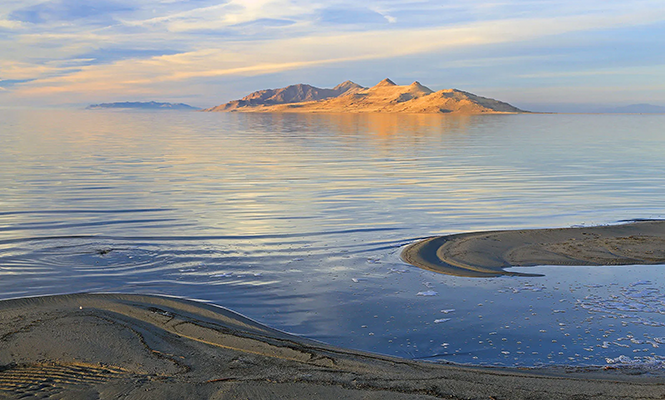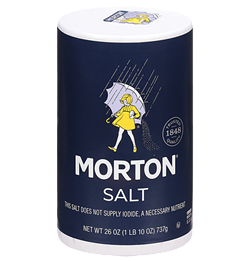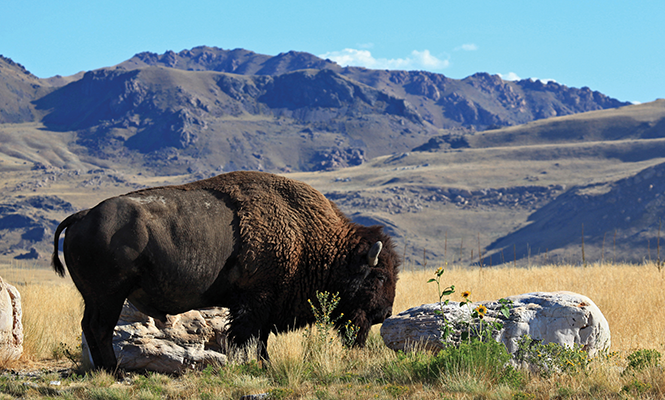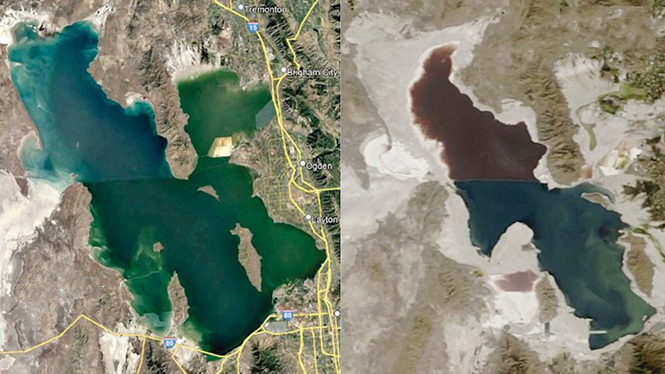
24 Jun Why Ya Gotta Be So Salty?
In a fight for its life, Utah’s inland sea inspires a new generation of lake protectors.
As namesake to Utah’s capital city, the Great Salt Lake lies west of communities from Salt Lake north to Ogden, all the way to Tremonton. Whether you’re seeing the lake from a hilltop home, office building or rooftop bar, it often shows up as a shimmering patch of blue on the western horizon. And no matter your vantage point, you just can’t help but admire its austere beauty.
As the last remnant of Lake Bonneville (which, back in the Ice Age, covered most of Utah), the Great Salt Lake is the largest saltwater lake in the Western Hemisphere. Fed with freshwater from the Jordan, Weber and Bear rivers, GSL is a terminal lake (meaning it has no outlet to the ocean). As such, GSL accumulates tons of minerals each year, which give the lake its high salinity (2 to 9 times saltier—depending on location—than seawater) and density. This density accounts for why swimmers often feel buoyant in the water.
The Lake Giveth
For more than a century, humans have divided the lake with railroad trestles, dikes and a causeway. Each lake fragment has its own salinity and color. Measuring 75 miles long and 35 miles wide, GSL is a vast, shallow basin, known for its “lake stink.” You’ll find no fish in this extra salty lake environment, but it’s the perfect home for brine shrimp, brine fly larvae and algae. The commercial harvest of brine shrimp represents an $80 million dollar-per-year industry, with the lake’s shrimp sold worldwide as fish and prawn food.
The shrimp and the lake’s billions of brine flies serve as tasty snacks for the more than 10 million migratory birds (more than 250 species) that touch down on the shores of the lake annually. Millions of native birds, shorebirds and waterfowl including ducks, geese, gulls, pelicans and eagles call the marshes and surrounding wetlands home.
The GSL also is a rich source of salt, magnesium, lithium and other minerals for companies ranging from Morton Salt to U.S. Magnesium. GSL mineral extractions contribute $1.3 billion a year to Utah’s economy, according to a 2019 report prepared for the Great Salt Lake Advisory Council, but the industries are also criticized for high water usage and pollution.
Those who come to Utah for winter recreation can also thank the GSL for enhancing the abundant snowfall they so enjoy. Skiers and boarders rejoice when the “lake effect” phenomenon kicks in as a cold storm front crosses over the warmer shallow GSL waters to produce unparalleled amounts of light fluffy powder in our mountains, dubbed “The Greatest Snow on Earth.”
Where’d All the Water Go?
Lately, however, the GSL has made national and international news out of concern for its receding waters.
Water that normally fills the lake has been increasingly diverted for agricultural, industrial and residential usage. Combine that with the effects of drought and climate change, and we’ve seen the lake recede by two-thirds (73%). In the fall of 2022, the GSL hit a record-low water level, and scientists warned of the lake’s extinction within five years. Not only that, but as shorelines recede, the GSL’s lakebed (where all the lake’s toxins have settled) is now exposed. Winds blow toxic dust from the lakebed into the air, creating a public health concern for residents living along the Wasatch Front.
Simply put, the lake needs more water. While Mother Nature helped out with a bountiful snowpack the past two winters, it isn’t near enough to replenish the basin.
Be the Change
What’s next: Prayers alone won’t save the Great Salt Lake. Utah environmental author Terry Tempest Williams and others have advocated giving the GSL legal “personhood” to recognize its inherent right to exist and flourish and to potentially allocate water rights to the lake. The Utah Legislature and governor nipped that idea in the bud but insist they are still dedicated to saving the GSL. To that end, they’ve appointed a GSL commissioner, Brian Steed, to oversee statewide preservation efforts.
Since 1994, the nonprofit Friends of the Great Salt Lake has kept watch over the Great Salt Lake ecosystem and helped increase public awareness through education, research, advocacy and the arts. Artists and activists from Save Our Great Salt Lake and the River Writing Collective heard the call and began holding vigil at the Capitol during the legislative session dressed in colorful bird and brine shrimp costumes. The groups also host consciousness-raising events throughout the year. Grow the Flow is also part of the effort, focused on restoring the lake through policy, innovation and citizen involvement.
A cohort of 19 local news, education and civic organizations calling themselves the Great Salt Lake Collaborative have banded together to inform and engage the public about working toward solutions to rescue the lake before it’s too late.
Get Your Feet Wet
Yes, the lake may be struggling, but it is far from dead. See it now, spend time at Great Salt Lake state parks and see why the lake inspires so much love and devotion. Enjoy wildlife viewing, birdwatching, hiking, full moon bike rides, camping, picnicking, kayaking, swimming and more at:
Antelope Island State Park and Visitor Center: 33 miles north of Salt Lake City. Access the park via a 7.2-mile causeway located 7 miles west of Interstate 15, exit 332, near Layton
Great Salt Lake State Park and Marina: 17 miles west of Salt Lake City on I-80, exit 104 (Saltair Drive). Open year round.
Willard Bay State Park marinas: Willard Bay is a freshwater reservoir 12 miles northwest of Ogden, on the flood plains of the Great Salt Lake. The north marina and campgrounds are located west of I-15, exit 357. The south marina and campgrounds are a little farther west of I-15, exit 351.
Bonneville Salt Flats
From Salt Lake City, drive 1½ hours west on Interstate 80 to discover a vast expanse of flat salt-encrusted earth used for land speed racing (Speedweek is usually held in early August). Since 1914, this unique landscape has brought land speed racers from around the world to test themselves and their vehicles on “fastest speedway on earth.” The salt flats are also the place for archery competitions, running races, photography, videography and research projects.
At 12 miles long and 5 miles wide, the flats appear to be covered in snow, but it’s actually a crust of salt that’s 5 feet thick in some places. Originally 96,000 acres, the salt flats themselves have been reduced by climate change and mineral extraction to 30,000 acres and a quarter-inch thickness in some spots.
Environmental Art
Spiral Jetty: This spectacular earth art sculpture on the northeastern shore of the GSL is a two-hour drive from downtown Salt Lake. In 1970, artist Robert Smithson trucked in more than 6,000 tons of black basalt rock to form a counterclockwise coil jetty that extends from the shore into the water. The jetty was submerged for decades but now the rocks are fully visible and walkable.
Sun Tunnels: This example of environmental art is from Robert Smithson’s widow, artist Nancy Holt. Located three hours northwest of Salt Lake in a ghost town called Lucin, here you’ll see four concrete tunnels 18 feet long and 9 feet in diameter arranged in an X-pattern and aligned to view the sunrise and sunset on the summer and winter solstices.
Metaphor: The Tree of Utah: This sculpture stands at the edge of Interstate 80 about 25 miles east of Wendover on the Bonneville Salt Flats. Constructed in the mid-1980s by Swedish artist Karl Momen, the work consists of a large concrete trunk with six orbs at the top meant to mimic branches, covered in more than 2,000 glossy ceramic tiles and minerals. On the ground next to the trunk are purposely broken pieces of an orb that appears to have fallen and cracked open, seeming to impart that nature is resilient even in the harsh conditions of the barren salt flats.
When It Rains, It Pours
 Table salt is ubiquitous, but you might think twice when you know that the world’s best-known flavor enhancer comes from the Great Salt Lake, specifically the Grantsville
Table salt is ubiquitous, but you might think twice when you know that the world’s best-known flavor enhancer comes from the Great Salt Lake, specifically the Grantsville
area.
Since 1918, Morton Salt Co. has been mining and harvesting table salt, water softening and deicing salt.
Salt production starts in March and harvests in November. Through solar evaporation during the warmer months, the sun evaporates water from precipitation in salt ponds leaving behind the ”white gold” that we can’t live without.






Sorry, the comment form is closed at this time.